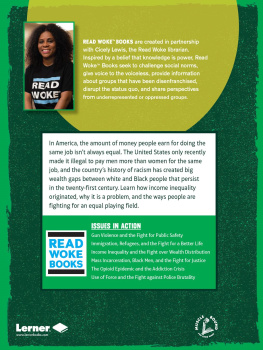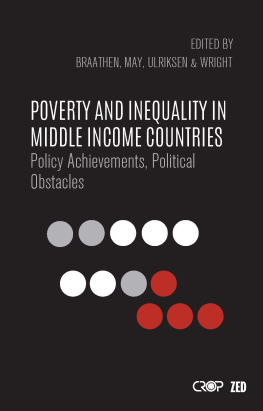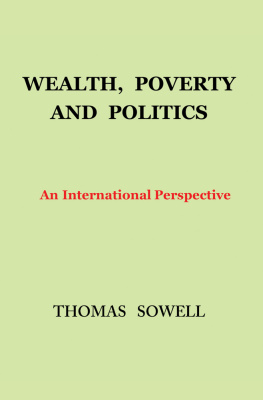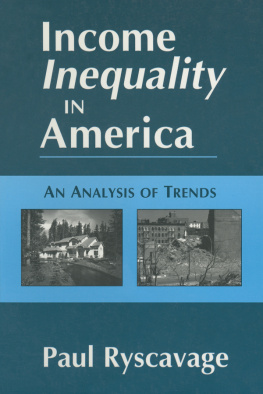Copyright 2003 by the President and Fellows of Harvard College
All rights reserved
Printed in the United States of America
First Harvard University Press paperback edition, 2006
Library of Congress Cataloging-in-Publication Data
Firebaugh, Glenn.
The new geography of global income inequality / Glenn Firebaugh.
p. cm.
Includes bibliographical references and index.
ISBN 0674-01067-1 (cloth)
ISBN 0674-01987-3 (pbk.)
1. Income distribution. I. Title.
HC79.I5 F565 2003
339.21dc21 2002038724
Designed by Gwen Nefsky Frankfeldt
This book is about global income inequalitythe uneven distribution of economic activity and welfare worldwide. The first and principal objective of the book is to set the facts straight about trends in global income inequality, an area in which there is much controversy and misunderstanding. For example, the World Banks World Development Report 2000/2001 (p. 51) claims that income inequality between countries has increased sharply over the past 40 years, and as recently as April 2001, an article in The Economist proclaimed that new evidence suggests that global inequality is worsening rapidly (Wade 2001, p. 72). Such claims are commonplace. An examination of the data, however, suggests that income inequality across nations peaked in the last third of the twentieth century and is now declining. At the same time, inequality within nationswhich had been declining over the first half of the twentieth centuryhas begun to rise. Because of industrializations spread to poor nations and the prospect of a demographic windfall for many of them, I expect these trends to continue. The result is a new geography of global inequality, wherecontrary to trends that dominated the nineteenth and early twentieth centuriesincome inequality declines across nations and rises within nations. This book documents this new geography, shows that the new geography has led to declining global income inequality, and explains why other analyses have wrongly concluded that global income inequality continues to grow.
These claims are likely to be met with skepticism in some quarters, so the bulk of the book documents and describes the new geographythe first objective. The second objective of the book is to determine what is behind the change in the contours of global inequality. The most important cause is the spread of industrialization to the worlds poor regions. Determining this and other causes puts us in a better position to determine whether the new patterns are likely to continuethe books third objective. The final chapter predicts that the patterns will continue in the twenty-first century. If that forecast proves to be correct, then we are in the middle of an inequality transition that will slowly reduce the link between nationality and income, so that in the future your income might be determined more by what you know than by where you live.
There is a great deal of interest these days in the topic of globalization and income inequality, and I seek to clear up misconceptions and to advance our knowledge in this important area. The book is written for scholars and students alike, and it is appropriate for a variety of undergraduate-and graduate-level courses, such as political science courses on international affairs or globalization, sociology courses on social stratification or social problems, and economics courses on economic development or income distribution and inequality.
Writing a book is a solo task embedded in a social context, and in the course of my work I have benefited greatly from the counsel of others. I begin by thanking David Grusky for his advice and encouragement throughout this project, and Jacob Felson, Christopher Jencks, Telle Kjetil, Dan Lichter, Jeff Manza, and Evan Schofer for their written comments on one or more of the chapters. At Penn State I have benefited from discussions with (and in some cases written comments from) David Baker, Cristina Bradatan, Jeffrey Cohen, Gordon DeJong, Richard Felson, Roger Finke, Brian Goesling, Mark Hayward, Barry Lee, John McCarthy, Sal Oropesa, Sean Reardon, Assata Richards, Robert Schoen, Pam Short, David Shapiro, and Alan Sica. I have also benefited from the good offices of the Population Research Institute (PRI) at Penn State, and I thank in particular Tonya Allen and Tara Murray for bibliographic assistance and Erica Gardner for programming assistance. The figures and maps in this book were prepared by Jim Detwiler (assisted by Jason Smith) in the Geographic Information System group in PRI.
I also thank Susan Welch, Dean of the College of the Liberal Arts, who saw enough potential in this project to grant a timely research leave. A cabin in Maine in the fall is an ideal place for putting together ones thoughts. The Sociology Program of the National Science Foundation also provided material support for the research underlying this book (grants SBR-9515153 and SBR-9870870), as did the National Institute of Child Health and Human Development through its Center Grant to PRI. are adapted from my article Empirics of World Income Inequality, American Journal of Sociology 104 ( 1999 by The University of Chicago; all rights reserved).
Over the past four years I have presented preliminary findings from this research in talks at the universities of Michigan and Wisconsin and at Cornell, Indiana, and Oxford universities, as well as at various academic conferences. Some in the audiences provided probing questions or criticisms, some provided timely encouragement, and some provided both. The list of those who provided at least one of the above includes Art Alderson, David Brady, Tom DiPrete, Steven Durlauf, Robert Hauser, Albert Hermalin, Michael Hout, David James, Leslie Kish, David Lam, Noah Lewin-Epstein, Michael Macy, Karl Ulrich Mayer, Patricia McManus, Victor Nee, David Sahn, Karl Schuessler, Donald Treiman, Wout Ultee, Pam Walters, Franklin Wilson, and Yu Xie. I have also benefited from email correspondence with Ian Castles, Ryan Hobert, Branko Milanovic, and Tim Smeeding on various issues related to global inequality.
I thank Michael Aronson at Harvard University Press, a superb editor, and Elizabeth Gilbert, a superb manuscript editor.
Finally, I thank my wife, Judy Rae, and my valued friends Barb, Carole, Dan, Don, Emory, Joan, Judy, Larry, and Lynda for their supportyou know who you are.
September 2002








